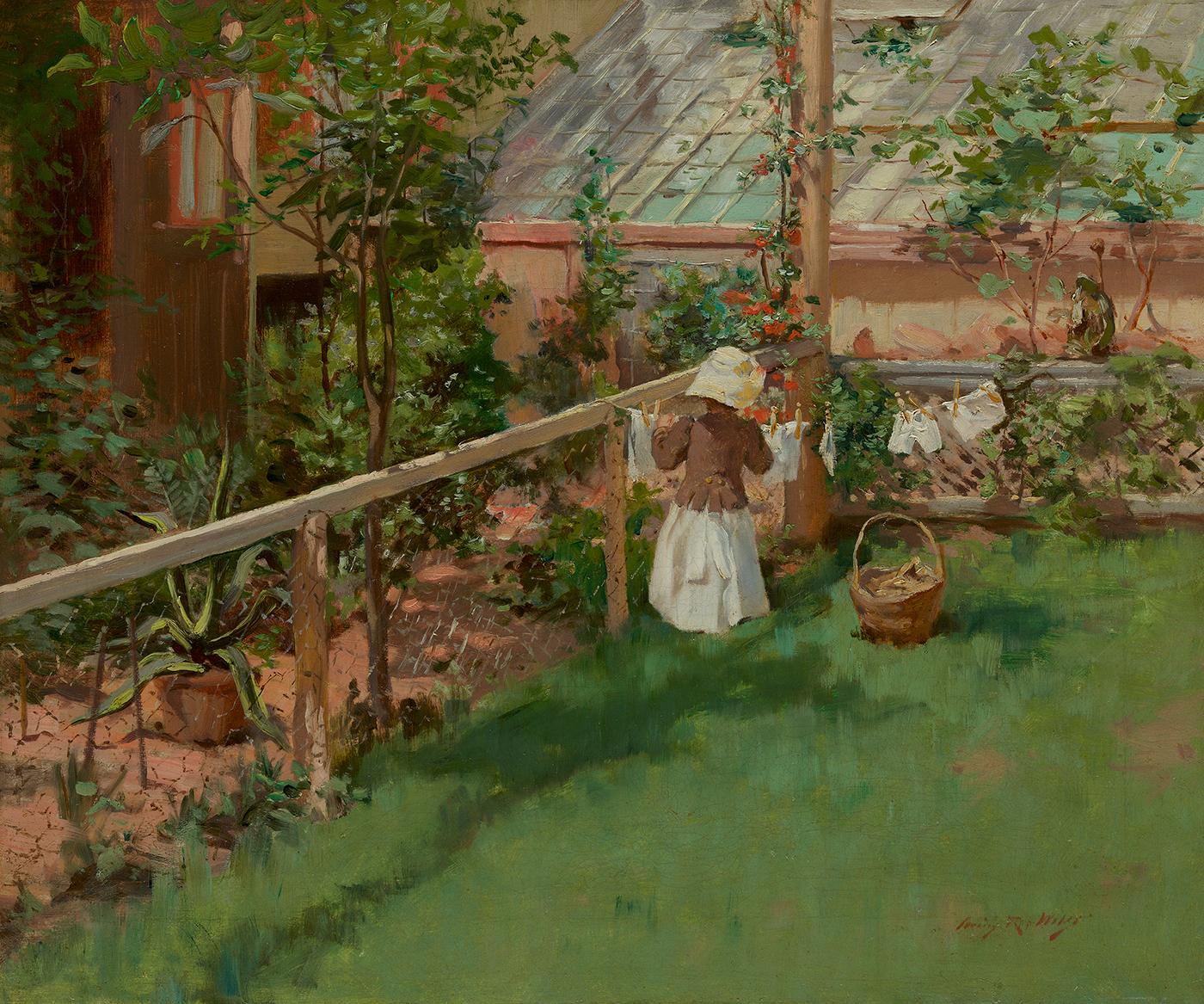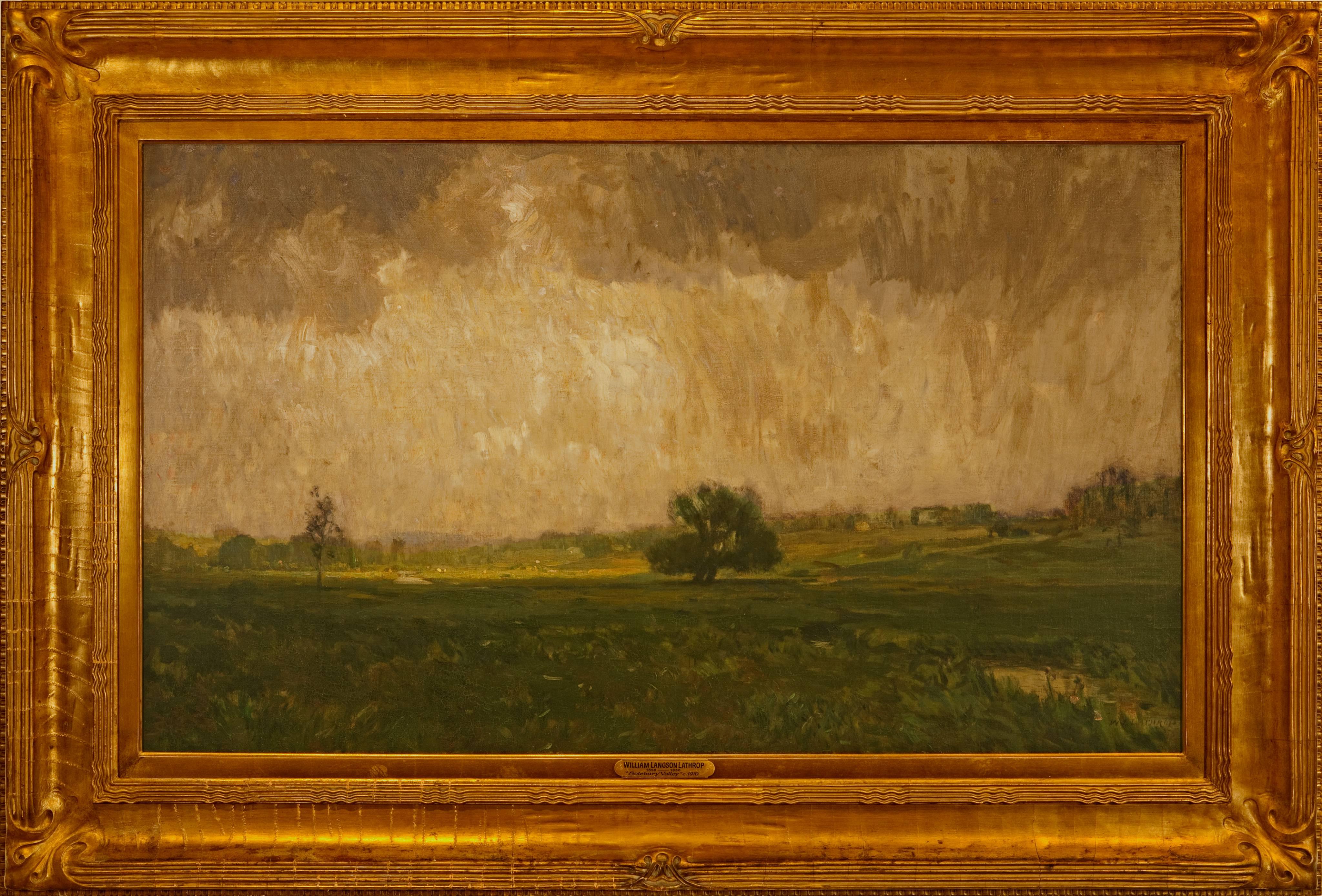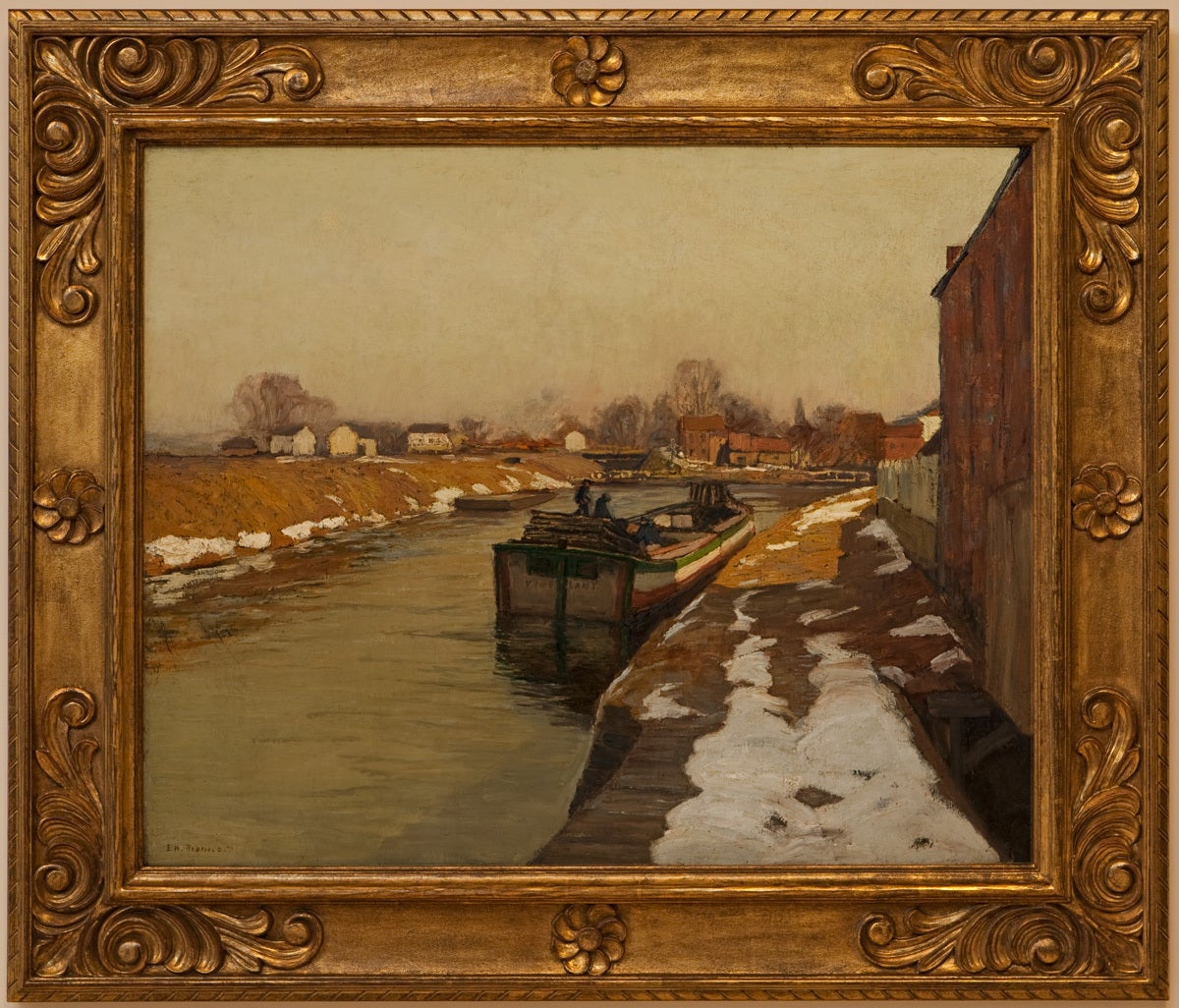Items Similar to Boulder Canyon, Framed 1940s Colorado Mountain Landscape in Autumn with Aspens
Video Loading
Want more images or videos?
Request additional images or videos from the seller
1 of 14
Irene FowlerBoulder Canyon, Framed 1940s Colorado Mountain Landscape in Autumn with Aspenscirca 1930-1950
circa 1930-1950
About the Item
Vintage circa 1930s-1950s original oil painting of Boulder Canyon - a Colorado Landscape painting with mountains and Aspen trees with autumn/fall coloring. Presented in a custom gold frame, outer dimensions measure 25 ¼ x 21 ¼ x 1 ½ inches. Image size is 22 ¼ x 18 ¼ inches.
About the Artist:
Born Illinois, 1884
Died Denver, Colorado 1969
An important figure in the development of Denver as an artistic city, Irene Fowler was a public school teacher and founding member of the Denver Artist’s Guild (now the Colorado Artist’s Guild) in addition to being a prolific artist.
She exhibited in Denver at the Schlier Gallery (where she had a solo exhibition), at the Chappell House, the University Club, and the Broadmoor Art Gallery in Colorado Springs. In 1950-1952 she served as president of the Denver Artist’s Guild.
Fowler painted in oil or watercolor and her paintings were almost exclusively done en plein air. Her landscapes of Colorado have all the usual features—mountains, aspen trees, quaint mining towns—described with a singular understanding of the thin air and luminous sunshine that make Colorado aesthetically unique.
Exhibited: Schlier Gallery, Denver; Chappell House, Denver; Denver Community Art Center; The University Club, Denver, 1957; and The Broadmoor Art Gallery, Colorado Springs; Colorado History Museum, 2003.
- Creator:Irene Fowler (1884 - 1967)
- Creation Year:circa 1930-1950
- Dimensions:Height: 25.25 in (64.14 cm)Width: 21.25 in (53.98 cm)Depth: 1.5 in (3.81 cm)
- Medium:
- Movement & Style:
- Period:
- Framing:Frame IncludedFraming Options Available
- Condition:very good to excellent vintage condition.
- Gallery Location:Denver, CO
- Reference Number:
About the Seller
5.0
Platinum Seller
These expertly vetted sellers are 1stDibs' most experienced sellers and are rated highest by our customers.
Established in 1979
1stDibs seller since 2013
265 sales on 1stDibs
Typical response time: 3 hours
- ShippingRetrieving quote...Ships From: Denver, CO
- Return PolicyA return for this item may be initiated within 7 days of delivery.
More From This SellerView All
- Sunset Along Front Range, Colorado, Impressionist Landscape Oil PaintingBy Charles Partridge AdamsLocated in Denver, COOil on canvas painting depicting a sunset along the front range of Colorado by Charles Partridge Adams (1858-1942). Unsigned, has a letter of authenticity from the estate included. Tonalist style landscape painting with large trees painted in hues of green, gold, orange, and brown. Presented in a vintage gold frame, outer dimensions measure 18 ½ x 26 ¼ inches. Image size is 16 x 24 inches. Expedited and International shipping is available - please contact us for a quote. About the Artist: Born Massachusetts, 1858 Died 1942 Born in Franklin, Massachusetts, Charles Partridge Adams moved with his mother and two sisters to Denver, Colorado, in 1876 in an effort to cure the two girls who suffered from tuberculosis. In Denver, Adams found work at the Chain and Hardy Bookstore. He received his first, and only, art training from the owner's wife, Helen Chain. Mrs. Chain, a former pupil of George Inness, provided instruction and encouragement to the young artist and introduced him to other artists in the area including Alexander Phimister Proctor...Category
20th Century American Impressionist Landscape Paintings
MaterialsCanvas, Oil
- Snowview of Baldwin (Kansas), 1980s Snow Landscape Oil Painting, Blue Gray WhiteLocated in Denver, COOil on canvas painting titled 'Snowview of Baldwin (Kansas)' painted in 1989 by Robert N. Sudlow (1920-2010) from 1989. Snowy landscape scene painted in shades of gray, brown, white,...Category
1980s American Impressionist Landscape Paintings
MaterialsCanvas, Oil
- Waterways (Lysekil, Sweden), 1930s Large Framed Seascape Landscape Oil PaintingBy Carl LindinLocated in Denver, COWaterways is an original 1920s-1930s signed framed oil painting of sailboats in off the coast of Lysekil, Sweden by Swedish-American Woodstock artist, Carl Lindin (1869-1942). Prese...Category
1920s American Impressionist Landscape Paintings
MaterialsOil, Canvas
- Crashing Waves and Rocks, California Coast, 1920s Seascape Marine Oil PaintingBy Charles Partridge AdamsLocated in Denver, COVintage marine seascape oil painting of waves crashing on rocks along the California coast by Charles Partridge Adams (1858-1942). Colors include blue,...Category
1920s American Impressionist Landscape Paintings
MaterialsOil, Canvas
- Sangre de Cristo Scene, Framed Taos New Mexico Mountain Landscape Oil PaintingBy Georgina KlitgaardLocated in Denver, COOriginal signed oil painting by Georgina Klitgaard (1893-1976), a Taos, New Mexico mountain landscape painting with figures walking in a meadow with ...Category
20th Century American Impressionist Landscape Paintings
MaterialsCanvas, Oil
- Stage Coach, Colorado Mountain Landscape, Vintage Western Oil PaintingBy Alfred WandsLocated in Denver, COVintage mountain landscape painting, oil on canvas of horses pulling a Stage Coach along the Front Range of Colorado by Alfred Wands (1904-1998). Autumn trees, golden grass, river and snowy mountains. Presented in a vintage frame, outer dimensions measure 29 ½ x 35 ½ x 1 inches. Image size is 24 x 30 inches. Painting is in very good condition - please contact us for a detailed condition report. Expedited and international shipping is available - please contact us for a quote. About the Artist: Born in Cleveland, Ohio, Alfred Wands graduated from the Cleveland School of Art with honors. Following that, he spent six months in Paris studying at the Academie Julian. In the late 1920's, Wands returned to Ohio to teach painting at the Cleveland School of Art and the Cleveland Museum of Art. In 1930, Wands moved to Denver to direct the art program at Colorado Women's College. He remained at the Women's College for the next 17 years. During his time in Denver, Wands frequently traveled to Taos, New Mexico. He and his family spent eleven summers there between 1930 and 1940. By 1943, he had become the Camp Artist at the YMCA of the Rockies, where he taught summer art classes. He later became the Chairman of their Religious Programs and Adult Advisory Committees. By 1947, he quit his teaching position at the Colorado Woman's College to devote full time to his painting. By 1955, Wands opened his own studio and gallery in Estes Park, Colorado. Known as the "Dean of Colorado Landscape Painters", he served three times as the President of the Denver Artists Guild. He was the Chairman of the Denver Art Commission for 16 years. Wands was a long-time member of the Denver Artists Guild and the Denver Art Commission. He was also a member of the Cleveland Society of Artists, Ohio Watercolor Society, and Chicago Galleries Association. ©David Cook Galleries...Category
20th Century American Impressionist Landscape Paintings
MaterialsOil, Canvas
You May Also Like
- At the ClotheslineBy Irving Ramsey WilesLocated in New York, NYSigned lower right: Irving R. WilesCategory
Late 19th Century American Impressionist Landscape Paintings
MaterialsCanvas, Oil
- "Alley Fiends"By John R. GrabachLocated in Lambertville, NJJim’s of Lambertville is proud to offer this artwork by: John R. Grabach (1886 - 1981) John Grabach was a highly regarded New Jersey artist, teacher, and author of the classic text...Category
1930s American Impressionist Landscape Paintings
MaterialsCanvas, Oil
- "Forest Strongholds"By John F. CarlsonLocated in Lambertville, NJSigned lower right. Complemented by a hand carved and gilt frame. Exhibited at the National Academy of Design, 1928Category
20th Century American Impressionist Landscape Paintings
MaterialsCanvas, Oil
- "Solebury Valley"By William Langson LathropLocated in Lambertville, NJSigned lower right. Complemented by a period frame. William L. Lathrop (1859-1938) Deemed “Father of the New Hope Art Colony”, William Langson Lathrop was born in Warren, Illinois. He was largely self-taught, having only studied briefly with William Merritt Chase in 1887, at the Art Students League. Lathrop first moved east in the early 1880s, and took a job at the Photoengraving Company in New York City. While there, he befriended a fellow employee, Henry B. Snell. The two men became lifelong friends and ultimately, both would be considered central figures among the New Hope Art Colony. Lathrop's early years as an artist were ones of continuing struggle. His efforts to break through in the New York art scene seemed futile, so he scraped enough money together to travel to Europe with Henry Snell in1888. There he met and married an English girl, Annie Burt. Upon returning to New York, he tried his hand at etching, making tools from old saw blades...Category
1910s American Impressionist Landscape Paintings
MaterialsCanvas, Oil
- Winter MoonlightBy George William SotterLocated in Lambertville, NJsigned lower rightCategory
1910s American Impressionist Landscape Paintings
MaterialsCanvas, Oil
- "The Canal"By Edward Willis RedfieldLocated in Lambertville, NJJim’s of Lambertville is proud to offer this artwork. Signed lower left. Complemented by a hand carved and gilt frame. Illustrated in "Edward Redfield: Just Values and Fine Seeing" by Constance Kimmerle and the Pennsylvania Academy of the Fine Arts's Exhibition of Paintings by Edward Redfield (April 17 to May 16, 1909) brochure Edward Willis Redfield (1869 - 1965) Edward W. Redfield was born in Bridgeville, Delaware, moving to Philadelphia as a young child. Determined to be an artist from an early age, he studied at the Spring Garden Institute and the Franklin Institute before entering the Pennsylvania Academy from 1887 to 1889, where he studied under Thomas Anshutz, James Kelly, and Thomas Hovenden. Along with his friend and fellow artist, Robert Henri, he traveled abroad in 1889 and studied at the Academie Julian in Paris under William Bouguereau and Tony Robert-Fleury. While in France, Redfield met Elise Deligant, the daughter of an innkeeper, and married in London in 1893. Upon his return to the United States, Redfield and his wife settled in Glenside, Pennsylvania. He remained there until 1898, at which time he moved his family to Center Bridge, a town several miles north of New Hope along the Delaware River. Redfield painted prolifically in the 1890s but it was not until the beginning of the twentieth century that he would develop the bold impressionist style that defined his career. As Redfield’s international reputation spread, many young artists gravitated to New Hope as he was a great inspiration and an iconic role model. Edward Redfield remained in Center Bridge throughout his long life, fathering his six children there. Around 1905 and 1906, Redfield’s style was coming into its own, employing thick vigorous brush strokes tightly woven and layered with a multitude of colors. These large plein-air canvases define the essence of Pennsylvania Impressionism. By 1907, Redfield had perfected his craft and, from this point forward, was creating some of his finest work. Redfield would once again return to France where he painted a small but important body of work between 1907 and 1908. While there, he received an Honorable Mention from the Paris Salon for one of these canvases. In 1910 he was awarded a Gold Medal at the prestigious Buenos Aires Exposition and at the Panama-Pacific Exposition of 1915 in San Francisco, an entire gallery was dedicated for twenty-one of his paintings. Since Redfield painted for Exhibition with the intent to win medals, his best effort often went into his larger paintings. Although he also painted many fine smaller pictures, virtually all of his works were of major award-winning canvas sizes of 38x50 or 50x56 inches. If one were to assign a period of Redfield’s work that was representative of his “best period”, it would have to be from 1907 to 1925. Although he was capable of creating masterpieces though the late 1940s, his style fully matured by 1907 and most work from then through the early twenties was of consistently high quality. In the later 1920s and through the 1930s and 1940s, he was like most other great artists, creating some paintings that were superb examples and others that were of more ordinary quality. Redfield earned an international reputation at a young age, known for accurately recording nature with his canvases and painting virtually all of his work outdoors; Redfield was one of a rare breed. He was regarded as the pioneer of impressionist winter landscape painting in America, having few if any equals. Redfield spent summers in Maine, first at Boothbay Harbor and beginning in the 1920s, on Monhegan Island. There he painted colorful marine and coastal scenes as well as the island’s landscape and fishing shacks. He remained active painting and making Windsor style furniture...Category
Early 1900s American Impressionist Landscape Paintings
MaterialsCanvas, Oil
Recently Viewed
View AllMore Ways To Browse
Framed 1940s
Vintage House Art
Vintage The Club
1940s Dior
Vintage Teacher Images
Vintage Mountain Art
University Vintage
Vintage Public
Dior 1952
18x18 Vintage Frame
1957 Dior
Aesthetic Vintage Landscape
Vintage Mountain Landscape
Vintage Fall Art
Vintage Colorado
Vintage Watercolor Artists
Dior Vintage Canvas
Vintage Watercolor Paintings





